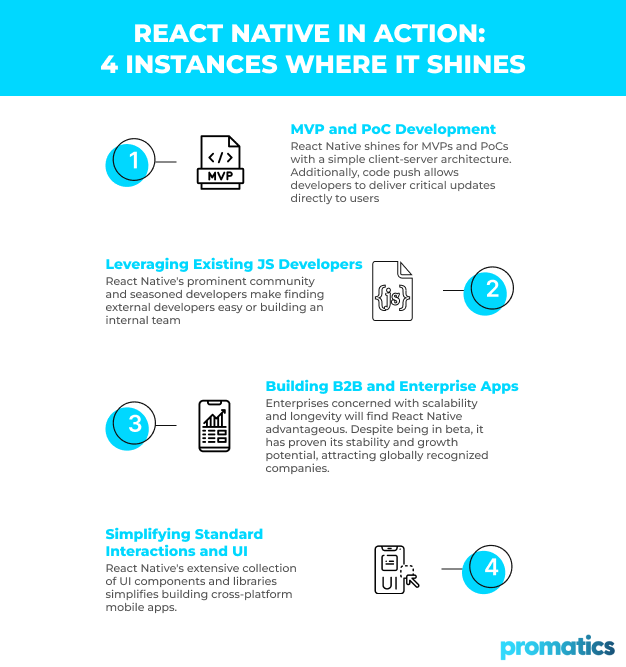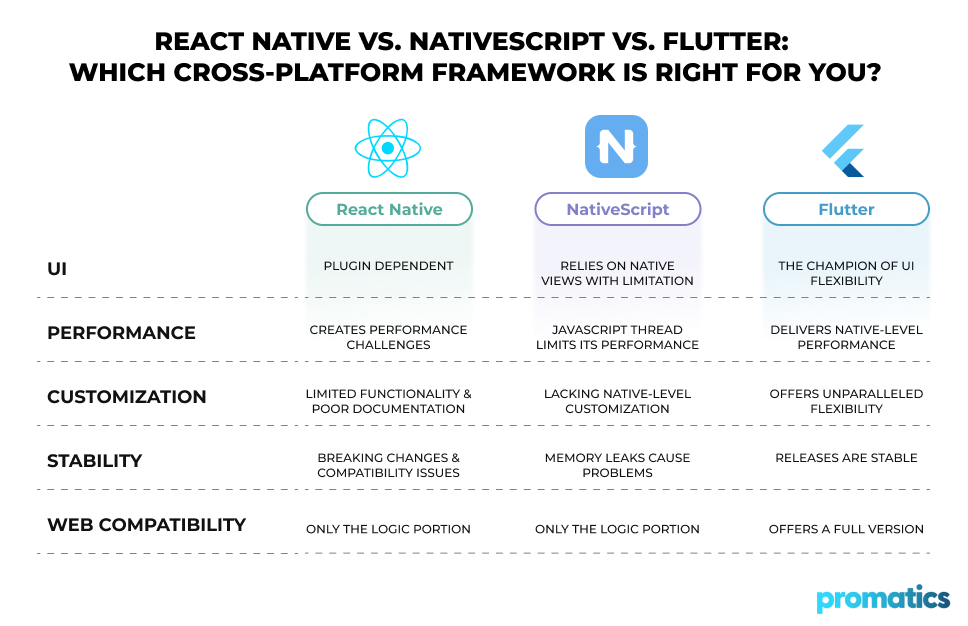React Native App Development Guide: Challenges and Best Practices
Table of Contents
- Navigating the Two Paths of React Native App Development
- Choosing the Right Path: Expertise Matters
- Unlocking the Power of React Native for Cross-Platform Success
- Evaluating the Trade-off: Native vs. Cross-Platform
- When React Native May not be the Optimal Choice
- Choosing Your Weapon: A Cross-Platform Showdown
- React Native Challenges and Best Practices
- Promatics India: Your React Native App Development Partner
- FAQs
- What are the key advantages of using React Native for cross-platform app development?
- How do I choose between React Native CLI and Expo for app development?
- When is React Native suitable for app development, and in which scenarios might it not be optimal?
- What challenges might be encountered in React Native app development, and how can they be addressed?
Revolutionizing the landscape of cross-platform app development, React Native emerges as a game-changer aligning with contemporary market demands, seamlessly integrating into the tech stack of numerous cutting-edge products. Offering an unparalleled blend of enhanced performance, flexibility, and the capability to craft sophisticated UI experiences, it beckons as the platform-agnostic framework of choice.
But, as you embark on this technological journey, having a trusted partner is critical, along with a profound understanding of the challenges and best practices that accompany React Native development.
Enter Promatics India, where React Native isn’t just a technology; it’s a realm where potential transforms into reality. With a wealth of experience executing diverse React Native projects, we’ve honed our understanding of when to embrace React Native and navigate its intricate landscape. In this article, we distill our insights to serve as your compass, guiding you through the inception and seamless execution of your React Native project.
Join us on this exploration where technology meets strategy, ensuring your venture is not just a project but a success story.
Navigating the Two Paths of React Native App Development
Building your dream app with React Native? Promatics India helps you navigate the two fundamental approaches: React Native CLI and Expo.
1. Forging Your Path: React Native CLI
Taking the reins with React Native CLI grants you ultimate freedom and control. You’ll directly craft standalone apps, deploying the required native environments and tools. This approach offers:
- Seamless integration of native features: Access and leverage native APIs and app components easily, tailoring the development experience to your needs.
- Cross-platform prowess: Develop for both iOS and Android using the familiar JavaScript and React languages.
- Powerful combination: Fuse the best of both worlds – the native performance and features with the agility and flexibility of React, a leading JavaScript library for building user interfaces.
2. The Simplified Path: Expo
Looking for a quicker and easier start? Expo offers a pre-built suite of tools designed to streamline React Native development. It provides:
- Instant access to native libraries: Leverage a collection of high-quality native libraries bundled together in ExpoKit, simplifying development and saving time.
- Reduced complexity: Expo’s user-friendly environment is ideal for beginners and web developers unfamiliar with react native mobile app development.
- Perfect for rapid prototyping: Quickly create prototypes, minimum viable products (MVPs), and proof-of-concept (PoC) solutions.
Choosing the Right Path: Expertise Matters
The best approach depends on your specific project and goals. Promatics India is experienced developers will guide you through decision-making, ensuring your app’s architecture aligns seamlessly with your requirements. We recommend Expo for:
- Prototyping and proof-of-concept projects
- Minimum viable product (MVP) development
- Projects with web developers unfamiliar with native development
However, for complex projects demanding customization and full control, React Native CLI might be the optimal choice.
Remember, the key to success lies in choosing the right path for your journey. Let Promatics India guide you on the exciting road to building exceptional React Native apps.
Unlocking the Power of React Native for Cross-Platform Success
Choosing between native and cross-platform development is crucial at the project’s outset. The UI, business logic, and functionality are critical in this choice. Cross-platform technology emerges as the ideal solution if your app boasts a shared business logic, identical UI across platforms, and lacks platform-dependent core functionality.
Evaluating the Trade-off: Native vs. Cross-Platform
To determine if cross-platform development is worthwhile, carefully assess the balance between platform-specific features and overall functionality. For projects requiring extensive native code for core functionality, native development remains preferred.
However, the rise of cross-platform solutions is undeniable, and Promatics India recommends React Native in the following four critical scenarios:
1. MVP and PoC Development
React Native shines for MVPs and PoCs with a simple client-server architecture. Often facing tight budgets and rapid time-to-market demands, startups benefit from its market popularity, customization flexibility, and features like “hot reloading support” that expedite and streamline development. Additionally, code push allows developers to deliver critical updates directly to users, bypassing the app store and ensuring rapid responsiveness to evolving needs.
2. Leveraging Existing JS Developers
React Native’s prominent community and seasoned developers make finding external developers easy or building an internal team. If you plan to involve JS developers for post-release support or already have a React-based infrastructure, React Native becomes the natural choice.
3.Building B2B and Enterprise Apps
Enterprises concerned with scalability and longevity will find React Native advantageous. Despite being in beta, it has proven its stability and growth potential, attracting globally recognized companies. Together with Node.js for the backend, it enables building fast, scalable, and networked applications. React Native’s codebase modifications can be applied simultaneously to iOS and Android, making maintenance and updates significantly smoother, a critical advantage for enterprise-level applications undergoing frequent updates.
4. Simplifying Standard Interactions and UI
React Native’s extensive collection of UI components and libraries simplifies building cross-platform mobile apps. While relying heavily on third-party resources presents potential risks regarding maintenance and updates, it facilitates the creation of straightforward and efficient user interfaces. However, for projects requiring complex, non-standard UI elements, React Native might not be the best choice. While plugins do exist to address this challenge, they require substantial technical expertise and time investment.
When React Native May Not Be the Optimal Choice
While React Native stands out as a versatile technology, there are instances where alternative options might be more suitable for specific business needs. Here are scenarios where other technologies may offer better solutions:
1.APPS WITH NATIVE-DEPENDENT FUNCTIONALITY
- Evaluate your project’s technical requirements and ascertain if cross-platform functionality meets your needs.
- For features reliant on platform-specific coding, such as AR development or Bluetooth connection, native Android and iOS development might be more appropriate.
2. APPS WITH COMPLEX NON-STANDARD UI
- When crafting intricate and unique user interfaces, Flutter surpasses React Native.
- Flutter’s high degree of customization makes it ideal for projects where a non-standard custom design is integral.
- For apps requiring a consistent UI across different platforms, Flutter’s independent rendering engine ensures uniformity.
While React Native remains versatile and adaptable to various business scenarios, considering alternatives like Flutter can be advantageous, especially when specific functionalities or complex UI designs are paramount to your project’s success. Explore the diverse landscape of technologies to find the perfect fit for your unique business requirements.
Choosing Your Weapon: A Cross-Platform Showdown
In cross-platform app development, three titans reign supreme: React Native, NativeScript, and Flutter. But which one deserves to be your weapon of choice? Let’s delve into their strengths and weaknesses across critical areas:
1. UI
- Flutter: The champion of UI flexibility, Flutter boasts its rendering engine, allowing you to craft intricate interfaces with blazing speed, sometimes even surpassing native apps.
- React Native: While flexible enough for most web-based UI needs, React Native lacks a complete set of native component counterparts. Community plugins fill the gap but with potential limitations.
- NativeScript: Like React Native, NativeScript relies on native views and inherits its limitations. However, it allows for greater flexibility to use Angular, Vue.js, and its UI framework.
2. Performance
- Flutter: This champion delivers native-level performance, even outperforming some native Android apps. Its unique architecture, divided into platform-specific embedder, engine, and framework layers, contributes to its speed.
- React Native: The bridge architecture, while undergoing updates, still creates performance challenges, particularly with animations and views requiring frequent updates.
- NativeScript: Its reliance on the JavaScript thread limits its performance compared to React Native, potentially impacting complex applications.
3. Customization
- Flutter: The undisputed king of customization offers unparalleled flexibility in building native-like UIs. You can define custom-painted views and layouts without relying on native platforms.
- React Native: While capable of custom paint, its limited functionality and poor documentation hinder its customization capabilities. Additionally, defining custom layouts requires opting into a native platform.
- NativeScript: While lacking native-level customization, developers can call native methods on views directly from JavaScript, enabling changes to platform-specific views.
4. Stability
- Flutter: Releases are stable, maintaining backward compatibility and ensuring apps remain functional. The maintainers are responsive to changes from Google and Apple, keeping the framework current.
- React Native: Being in beta, it experiences breaking changes and compatibility issues with new native platform releases. However, stability is generally good, and the community often steps up to fix issues with third-party libraries.
- NativeScript: Occasional memory leaks can occur, potentially causing problems for developers unfamiliar with the framework’s intricacies. Addressing these issues may take longer compared to other frameworks.
5. Web Compatibility
- Flutter: Offers a full version for creating web and desktop apps, though capabilities are limited compared to mobile development.
- React Native: Only the logic portion of your application can be shared with the web.
- NativeScript: Similar to React Native, only the logic portion can be shared with the web.
Choosing between Flutter and React Native is fundamentally a strategic business decision. Flutter distinguishes itself with an independent rendering engine, ensuring a consistent appearance across diverse platforms.
Conversely, React Native relies on platform-native elements, potentially resulting in varied component appearances.
A notable advantage of React Native lies in its utilization of JavaScript (JS). The flexibility and accessibility of JS make it an advantageous choice, especially if a company possesses existing JS developers or a substantial pool of JS talent in the market. Opting for React Native could be the preferred route, particularly for companies aiming to maintain their app independently and leverage the familiarity and abundance of JS resources.
React Native Challenges and Best Practices
While React Native’s praises are sung loud and clear, it’s not without its hurdles. Here’s a closer look at some challenges and how to overcome them:
1. UI Customization:
- React.js covers many cases, but custom UIs may require more effort due to limited native components.
- Community plugins bridge the gap for standard components, but bespoke solutions demand expertise.
- Consider performance limitations of React Native lists, especially for beginners.
2. Native Dependencies:
- Vendor updates can affect app performance, requiring proactive solutions from experienced teams.
- Involve native developers for custom solutions and platform-specific understanding.
3. Development Expertise:
- Not all developers grasp both web and mobile nuances, leading to potential mistakes.
- Utilize Expo for web developers unfamiliar with mobile development.
- Dedicate resources to upgrading plugins and resolving compatibility issues.
- Invest in team members with native code and infrastructure expertise.
4. Code Sharing:
- Sharing code between web and mobile platforms is limited.
- React Native uses native elements, while React.js relies on DOM elements.
- Only source code and non-DOM libraries are reusable.
- Modifying code for reuse might be less efficient than building new mobile logic.
- Skilled engineers are crucial for truly cross-platform solutions.
5. Performance and Stability:
- React Native being in beta can lead to occasional compatibility challenges with updates.
- Implement updates after they demonstrate stability.
- Updates indicate ongoing improvements and usually don’t affect projects.
- Seasoned teams can quickly fix issues arising from updates.
- New Architecture and Hermes engine improve performance and stability.
Remember, challenges can be overcome with the right expertise and best practices. Choose Promatics India to navigate the React Native journey and unlock its full potential.
Promatics India: Your React Native App Development Partner
Promatics India’s comprehensive understanding of React Native application development makes us the perfect partner for your business success. With over 13 years of experience in the software development landscape, we have a proven track record of delivering projects across diverse scales and complexities.
Our in-house team of cross-platform and native developers provides unparalleled expertise, ensuring solutions that perfectly align with your specific goals.
Whether you seek to:
- Modernize your existing app: Infuse your existing application with the latest React Native features and functionalities, revitalizing its user experience.
- Develop a groundbreaking product from scratch: Translate your innovative ideas into a user-centric and highly engaging mobile app with our expert guidance.
- Augment your existing development team: Enhance your internal capabilities with our skilled React Native developers, guaranteeing efficient project execution and timely delivery.
Promatics India is here to guide you every step of the way. Contact us today to discuss your unique requirements and experience the transformative power of React Native app development in partnership with Promatics India.
Frequently Asked Questions
What are the key advantages of using React Native for cross-platform app development?
React Native for app development offers enhanced performance, flexibility, and the ability to create sophisticated UI experiences. It seamlessly integrates into the tech stack, making it a preferred platform-agnostic framework for cutting-edge products.
How do I choose between React Native CLI and Expo for app development?
The choice between React Native CLI and Expo depends on your project’s requirements. React Native CLI provides ultimate freedom and control, while Expo offers a simplified path with pre-built tools. The decision should align with your project’s complexity and development preferences.
When is React Native suitable for app development, and in which scenarios might it not be optimal?
React Native is ideal for MVPs, PoCs, B2B, and enterprise apps, leveraging existing JS developers and simplifying standard interactions and UI. However, alternatives like Flutter might be more appropriate for apps with native-dependent functionality or complex non-standard UI.
What challenges might be encountered in React Native app development, and how can they be addressed?
Challenges in React Native App development include UI customization, native dependencies, development expertise, code-sharing limitations, and performance concerns. Overcoming these challenges requires expertise, the involvement of native developers, and strategic decision-making based on project requirements.
Read more:
Still have your concerns?
Your concerns are legit, and we know how to deal with them. Hook us up for a discussion, no strings attached, and we will show how we can add value to your operations!


